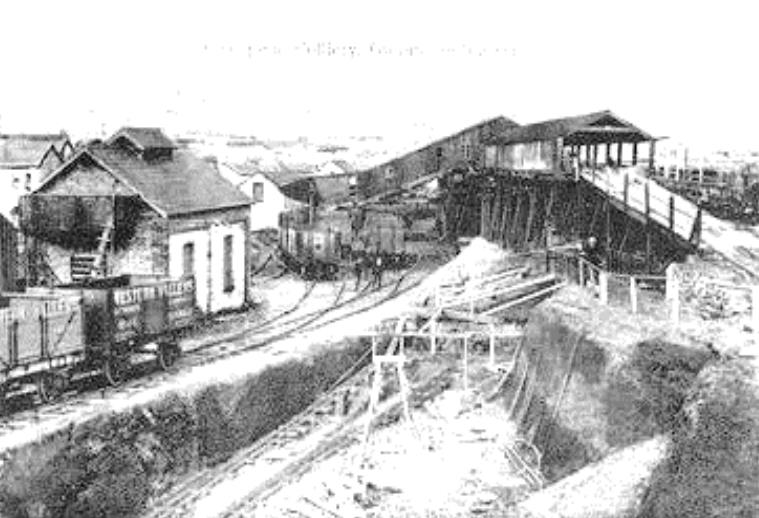 Gwaun-cae-Gurwen, Amman Valley (707110)
Gwaun-cae-Gurwen, Amman Valley (707110)
This anthracite slant was also called Red Vein Colliery Slant and was driven c1880 by Joseph Thomas (a local shopkeeper) into the outcrop of the Red Vein, which it worked at a section of cl.5 metres. The railway serving this mine was opened in August 1901, prior to this the coal was transported by horse and cart. The Red Vein dipped at 1 in 7 but then rose again to the south for 200 metres before continuing its normal dip. At 1,672 yards south of the mouth of the slant the seam was 477 yards lower. It was owned by the Cwmgorse Colliery Company Limited and in1896 only employed 12 men underground and 4 men on the surface.
By 1913 the New Cwmgorse Slant (formerly Llwynrhydiau) employed 380 men under the ownership of the New Cwmgorse Colliery Company Limited, which was a subsidiary of Cleeve’s Western Valleys Anthracite Company and was not a member of the Monmouthshire and South Wales Coal Owners Association. In 1916 it employed 410 men with the manager being M. Williams. The Western Valleys Anthracite Company advertised their wares in 1913 as:
Finest qualities of Anthracite For Breaking & Cobbles, Nuts, Washed Pea Nuts, Peas Etc.
Specially prepared Anthracite for Gas Producer Plants.
Collieries:- Cross Hands, Tirydail, Cwmgorse, Raven, Closyryn, and Llandebie.
Shipping:- Facilities For Shipping at Swansea, Llanelly or Burry Port.
Steamers Bunkered.
In 1919 Cwmgorse coal was mainly used for hop drying, lime burning, blast furnaces and horticultural purposes. Cleeve’s held control of Cwmgorse Colliery until 1923 when the Company became part of the newly formed Amalgamated Anthracite Collieries Limited it had its own coal preparation plant (washery) and was still managed by M. Williams and along with Cawdor it employed 286 men working underground and 65men working at the surface producing 200,000 tons of coal.
In 1930 Mr. Williams was still the manager and it employed 365 miners. It was managed by D. Jones in 1934 and by G.E.R. Robbings in 1943/5 when it employed 269 men working underground in the Red Vein and 98 men working at the surface of the mine.
Amalgamated Anthracite Collieries retained control of this colliery until Nationalisation in 1947. On Nationalisation the Colliery was placed in the National Coal Board’s, South Western Division’s, No.1 (Swansea) Area, and employed 95 men on the surface and 267 men underground working the Red Vein. The manager at that time was G. Robbings.
In 1949 W.A. Davies was the manager and this colliery employed 274 men working underground and 87 men working at the surface of the mine producing 72,000 of coal. In 1954/55 this colliery was one of 42 that caused concern to both the NUM and the NCB over the high levels of accidents.
In 1956 out of a total of 514 men working at this colliery, 224 of them worked at the coalfaces, this figure remained fairly stable throughout the rest of its working life; 220 men were working at the coalfaces in 1958, and in 1961, 233 men were employed on the coalface and 546 men at the slant overall. In 1961 this colliery was in the No.9 Neath Area’s, No.4 Group, along with East, Ammanford, Pantyffynnon, Wernos and Abernant collieries. This Group employed a total of 2,838 men and produced 485,647 tons of coal in that year. The Group Manager was E.G. Maggs, while the Area Manager was C. Round.
Cwmgorse Colliery was closed on the 9th of May 1964 because its manpower was needed at more profitable collieries.
Just some of those that died at this mine:
- 18/10/1910, E.H. Davies, Age: 23: Collier: Fall of the roof at the working face.
- 22/01/1912, Roger Nard, Age: 18: Collier boy: Fall of the roof at face after shot firing.
- 16/05/1914, Richard Lewis Edwards, Age: 17: Collier boy: Fall of the roof on stall road.
- 12/08/1914, Evan Jones, Age: 52: Collier: Fall of the roof at the face.
- 12/01/1926, Edward Thomas, Age: 37: Collier: fall of roof.
- January 1942, D. Edwards, Age: 49 years: Repairer: killed on a Sunday morning in an explosion of firedamp.
- January 1942, Daniel B Evans, Age: 41 years: Fireman: killed on a Sunday morning in an explosion of firedamp.
Some Statistics:
- 1899: Manpower: 30.
- 1900: Manpower: 55.
- 1907: Manpower: 255.
- 1913: Manpower: 380.
- 1923: Manpower: 362.
- 1924: Manpower: 360.
- 1927: Manpower: 363.
- 1928: Manpower: 390.
- 1930: Manpower: 365.
- 1937: Manpower: 402.
- 1943/5: Manpower: 367.
- 1947: Manpower: 362.
- 1948: Manpower: 361. Output: 72,000 tons.
- 1953: Manpower: 491 Output: 121,800 tons
- 1954: Manpower: 519. Output: 114,677 tons.
- 1955: Manpower: 531. Output: 123,902 tons.
- 1956: Manpower: 514. Output: 96,318 tons.
- 1957: Manpower: 515. Output: 81,904 tons.
- 1958: Manpower: 493. Output: 99,441 tons.
- 1960: Manpower: 551. Output: 104,978 tons.
- 1961: Manpower: 546. Output: 101,466 tons.
NEW CWMGORSE COLLIERY
Cwmgorse, Amman Valley
This anthracite slant was working as early as 1859 under the name of Llwynrhydiau Colliery. It was situated just to the north of Cwmgorse village adjacent to the brickworks. It was worked in 1915 by the New Cwmgorse Colliery Company which was not a member of the Monmouthshire and South Wales Coal Owners Association and in that year employed 410 with the manager being M. Williams. In 1918 it employed 263 men underground and 61 men on the surface and still employed M. Williams as manager. This colliery was not listed in 1913 or 1921.
Some statistics:
- 1901: Manpower: 118.
- 1902: Manpower: 160.
- 1905: Manpower: 202.
- 1909: Manpower: 264.
- 1910: Manpower: 330.
- 1911: Manpower: 314.
- 1912: Manpower: 401.
- 1915: Manpower: 410.
- 1918: Manpower: 324.
- 1920: Manpower: 410.
- 1922: Manpower: 360.
Information supplied by Ray Lawrence and used here with his permission.
Return to previous page
